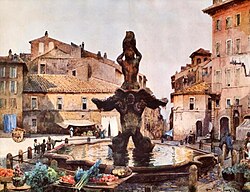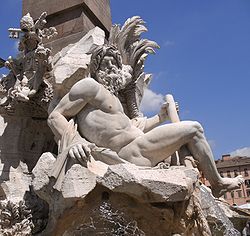




This is a list of the notable fountains in Rome, Italy. Rome has fifty monumental fountains and hundreds of smaller fountains, over 2000 fountains in all, more than any other city in the world. [1] [2]





This is a list of the notable fountains in Rome, Italy. Rome has fifty monumental fountains and hundreds of smaller fountains, over 2000 fountains in all, more than any other city in the world. [1] [2]
For more than two thousand years fountains have provided drinking water and decorated the piazzas of Rome. During the Roman Empire, in 98 AD, according to Sextus Julius Frontinus, the Roman consul who was named curator aquarum or guardian of the water of the city, Rome had nine aqueducts which fed 39 monumental fountains and 591 public basins, not counting the water supplied to the Imperial household, baths and owners of private villas. Each of the major fountains was connected to two different aqueducts, in case one was shut down for service. [3]
After the fall of the Western Roman Empire, the aqueducts were wrecked or fell into disrepair, and the fountains stopped working. In the 15th century, Pope Nicholas V (1397–1455), a scholar who commissioned hundreds of translations of ancient Greek classics into Latin, decided to embellish the city and make it a worthy capital of the Christian world. In 1453 he began to rebuild the Acqua Vergine, the ruined Roman aqueduct which had brought clean drinking water to the city from eight miles (13 km) away. He also decided to revive the Roman custom of marking the arrival point of an aqueduct with a mostra, a grand commemorative fountain. He commissioned the architect Leon Battista Alberti to build a wall fountain where the Trevi Fountain is now located. Alberti restored, modified, and expanded the aqueduct that supplied both the Trevi Fountain as well as the famous baroque fountains in the Piazza del Popolo and Piazza Navona. [4]
One of the first new fountains to be built in Rome during the Renaissance was the Fountain in Piazza Santa Maria in Trastevere (1499), which was placed on the site of an earlier Roman fountain. Its design, based on an earlier Roman model, with a circular vasque on a pedestal pouring water into a basin below, became the model for many other fountains in Rome, and eventually for fountains in other cities, from Paris to London. [5]
During the 17th and 18th century the Roman popes reconstructed other ruined Roman aqueducts and built new display fountains to mark their termini, launching the golden age of the Roman fountain. The fountains of Rome, like the paintings of Rubens, were expressions of the new style of Baroque art. They were crowded with allegorical figures, and filled with emotion and movement. In these fountains, sculpture became the principal element, and the water was used simply to animate and decorate the sculptures. They, like baroque gardens, were "a visual representation of confidence and power." [6]
The most famous Roman fountains of this period include:
The fountains of Rome all operated purely by gravity- the source of water had to be higher than the fountain itself, and the difference in elevation and distance between the source and the fountain determined how high the fountain could shoot water. The fountain in St. Peter's Square was fed by the Paola aqueduct, restored in 1612, whose source was 266 feet (81 m) above sea level, which meant it could shoot water twenty feet up from the fountain. The Triton fountain benefited from its location in a valley, and the fact that it was fed by the Aqua Felice aqueduct, restored in 1587, which arrived in Rome at an elevation of 194 feet (59 m) above sea level (fasi), a difference of 130 feet (40 m) in elevation between the source and the fountain, which meant that the water from this fountain jetted sixteen feet straight up into the air from the conch shell of the Triton. [7]
The fountains of Piazza Navona, on the other hand, took their water from the Acqua Vergine, which had only a 23-foot (7.0 m) drop from the source to the fountains, which meant the water could only fall or trickle downwards, not jet very high upwards. For the Trevi Fountain, the architect Nicola Salvi compensated for this problem by sinking the fountain down into the ground, and by carefully designing the cascade so that the water churned and tumbled, to add movement and drama. [8]
Today all of the fountains have been rebuilt, and the Roman water system uses both gravity and mechanical pumps. Water is recycled and water from different aqueducts is sometimes mixed before it reaches the fountains and performs for the spectators. [9]
This (incomplete) list contains important fountains in the city:
These fountains were built at the termini of the restored aqueducts of Rome, to supply water to the population and to glorify the Popes who built them.
These fountains were linked to the restored aqueducts, decorated the piazzi, or squares, of Rome, and provided drinking water to the population around the squares.